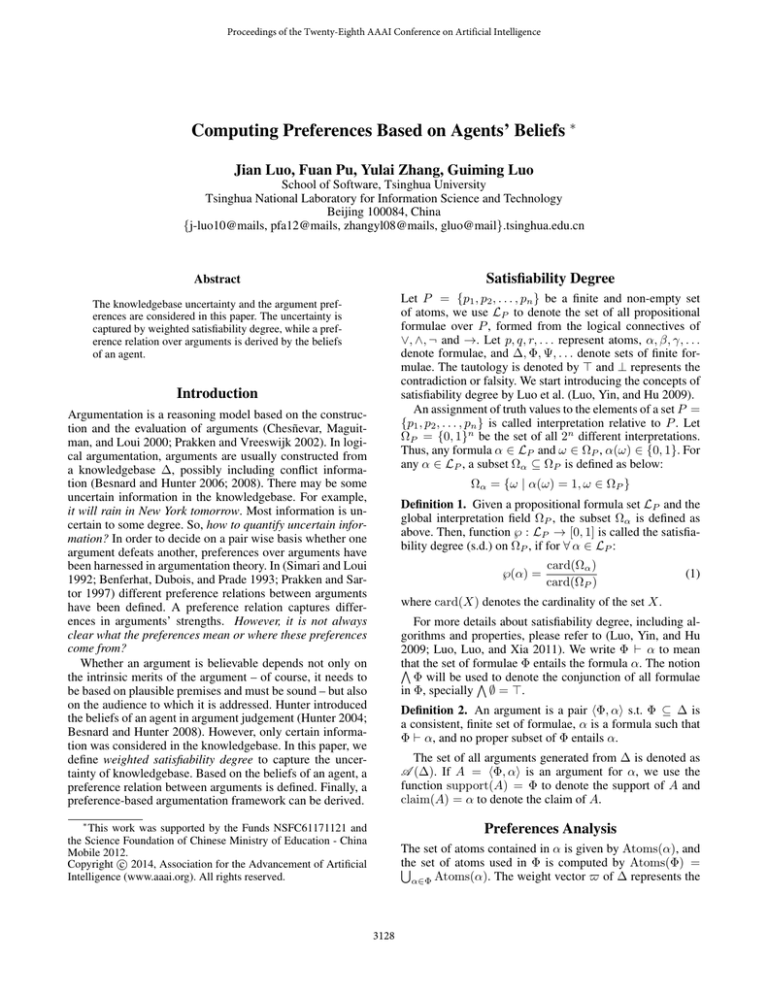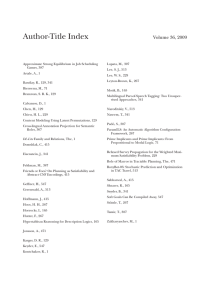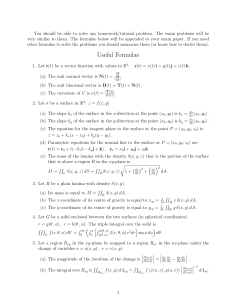
Proceedings of the Twenty-Eighth AAAI Conference on Artificial Intelligence
Computing Preferences Based on Agents’ Beliefs ∗
Jian Luo, Fuan Pu, Yulai Zhang, Guiming Luo
School of Software, Tsinghua University
Tsinghua National Laboratory for Information Science and Technology
Beijing 100084, China
{j-luo10@mails, pfa12@mails, zhangyl08@mails, gluo@mail}.tsinghua.edu.cn
Satisfiability Degree
Abstract
Let P = {p1 , p2 , . . . , pn } be a finite and non-empty set
of atoms, we use LP to denote the set of all propositional
formulae over P , formed from the logical connectives of
∨, ∧, ¬ and →. Let p, q, r, . . . represent atoms, α, β, γ, . . .
denote formulae, and ∆, Φ, Ψ, . . . denote sets of finite formulae. The tautology is denoted by > and ⊥ represents the
contradiction or falsity. We start introducing the concepts of
satisfiability degree by Luo et al. (Luo, Yin, and Hu 2009).
An assignment of truth values to the elements of a set P =
{p1 , p2 , . . . , pn } is called interpretation relative to P . Let
ΩP = {0, 1}n be the set of all 2n different interpretations.
Thus, any formula α ∈ LP and ω ∈ ΩP , α(ω) ∈ {0, 1}. For
any α ∈ LP , a subset Ωα ⊆ ΩP is defined as below:
The knowledgebase uncertainty and the argument preferences are considered in this paper. The uncertainty is
captured by weighted satisfiability degree, while a preference relation over arguments is derived by the beliefs
of an agent.
Introduction
Argumentation is a reasoning model based on the construction and the evaluation of arguments (Chesñevar, Maguitman, and Loui 2000; Prakken and Vreeswijk 2002). In logical argumentation, arguments are usually constructed from
a knowledgebase ∆, possibly including conflict information (Besnard and Hunter 2006; 2008). There may be some
uncertain information in the knowledgebase. For example,
it will rain in New York tomorrow. Most information is uncertain to some degree. So, how to quantify uncertain information? In order to decide on a pair wise basis whether one
argument defeats another, preferences over arguments have
been harnessed in argumentation theory. In (Simari and Loui
1992; Benferhat, Dubois, and Prade 1993; Prakken and Sartor 1997) different preference relations between arguments
have been defined. A preference relation captures differences in arguments’ strengths. However, it is not always
clear what the preferences mean or where these preferences
come from?
Whether an argument is believable depends not only on
the intrinsic merits of the argument – of course, it needs to
be based on plausible premises and must be sound – but also
on the audience to which it is addressed. Hunter introduced
the beliefs of an agent in argument judgement (Hunter 2004;
Besnard and Hunter 2008). However, only certain information was considered in the knowledgebase. In this paper, we
define weighted satisfiability degree to capture the uncertainty of knowledgebase. Based on the beliefs of an agent, a
preference relation between arguments is defined. Finally, a
preference-based argumentation framework can be derived.
Ωα = {ω | α(ω) = 1, ω ∈ ΩP }
Definition 1. Given a propositional formula set LP and the
global interpretation field ΩP , the subset Ωα is defined as
above. Then, function ℘ : LP → [0, 1] is called the satisfiability degree (s.d.) on ΩP , if for ∀ α ∈ LP :
℘(α) =
card(Ωα )
card(ΩP )
(1)
where card(X) denotes the cardinality of the set X.
For more details about satisfiability degree, including algorithms and properties, please refer to (Luo, Yin, and Hu
2009; Luo, Luo, and Xia 2011). We write Φ ` α to mean
that
V the set of formulae Φ entails the formula α. The notion
Φ will be used
V to denote the conjunction of all formulae
in Φ, specially ∅ = >.
Definition 2. An argument is a pair hΦ, αi s.t. Φ ⊆ ∆ is
a consistent, finite set of formulae, α is a formula such that
Φ ` α, and no proper subset of Φ entails α.
The set of all arguments generated from ∆ is denoted as
A (∆). If A = hΦ, αi is an argument for α, we use the
function support(A) = Φ to denote the support of A and
claim(A) = α to denote the claim of A.
∗
Preferences Analysis
This work was supported by the Funds NSFC61171121 and
the Science Foundation of Chinese Ministry of Education - China
Mobile 2012.
c 2014, Association for the Advancement of Artificial
Copyright Intelligence (www.aaai.org). All rights reserved.
The set of atoms contained in α is given by Atoms(α), and
the
S set of atoms used in Φ is computed by Atoms(Φ) =
α∈Φ Atoms(α). The weight vector $ of ∆ represents the
3128
{ω4 , ω6 }. Consider the weight vector $(p1 , p2 , p3 ) =
(1/3, 1/2, 3/4), the evaluating results are given as follows:
℘$ (α) = 1/6, ℘$ (β) = 23/24, ℘$ (β | α) = 3/4.
So, β is more satisfiable than α due to ℘$ (β) > ℘$ (α).
A Vbeliefbase B on ∆ is a set of formulae such that
℘$ ( B) > 0. The preference defined below reflects how
much an agent supports an argument under his/her beliefs.
Definition 6. Let A ∈ A (∆), $ on Atoms(∆), and B
be a beliefbase. The preference for A under B, denoted as
κ(A, B), is defined:
^
^
κ(A, B) = ℘$ ( S(A) |
B)
(4)
weight assignments for atoms in Atoms(∆). Consider a formula α as a whole with two interpretations true and false.
Assign some weights to both interpretations as weight(1)
and weight(0) representing the weights for the true interpretation and the false interpretation such that
weight(1) + weight(0) = 1
where weight(1), weight(0) ∈ [0, 1].
Let P = {p1 , p2 , . . . , pn } where each pi has weighted
$
interpretations weight$
pi (1) and weightpi (0) such that
$
weight$
pi (1) = $(pi ), weightpi (0) = 1 − $(pi ).
Definition 3. Let ΩP be the global field and $ a weight
vector on P , the weight of ω ∈ ΩP , denoted as weight$ (ω),
is defined:
n
Y
weight$ (ω) =
[ωi · $(pi ) + (1 − ωi ) · (1 − $(pi ))] (2)
Example 2. Consider the argument A1 = h{¬p∧¬q}, ¬(p∧
q)i and the weight vector $(p, q) = (1/2, 2/3). Given the
beliefbase B = {p∨q}, then the preference κ(A1 , B) = 1/9.
Proposition 4. Given a knowledgebase ∆, $ on Atoms(∆)
and a beliefbase B, a preference-based argumentation
framework (A, R, prefs) can be derived where: 1) A ⊆
A (∆);
V 2) R ⊆ A × A and ∀ (A1 , A2 ) ∈ R,
℘$ ( support(A2 ) | claim(A1 )) = 0; 3) prefs ⊆ A × A
s.t. ∀ (A1 , A2 ) ∈ prefs iff κ(A1 , B) > κ(A2 , B).
i=1
where ω = (ω1 , . . . , ωn ), and ωi ∈ {0, 1}(1 ≤ i ≤ n).
Proposition 1. Given a weight vector $ on an atom set P
and the global field ΩP for interpreting LP , then
X
weight$ (ω) = 1
Conclusions
ω∈ΩP
Definition 4. Given a weight vector $ on P , and the global
interpretation field ΩP . The weighted satisfiability degree
(w.s.d.) of α ∈ LP is defined as ℘$ (α):
X
℘$ (α) =
weight$ (ω)
(3)
In this paper, classical logic is used for generating arguments. A weight vector is given to represent the weight assignments for atoms in the uncertain knowledgebase. This
vector is then used to induce the weighted satisfiability degree. Based on the beliefs of an agent, preference is proposed to measure how much an agent supports an argument.
Finally, a preference-based argumentation framework can be
derived from the knowledgebase given the beliefbase.
ω∈Ωα
The w.s.d. describes the satisfiable extent of any formula
in LP given $. Specially, there is a weight vector $m such
that $m (pi ) = 1/2 for any p ∈ P , then weight$ (ω) =
1/2n (card(P ) = n) for any ω ∈ ΩP . In this case, the
w.s.d. of α is the same as the s.d. of α.
References
Benferhat, S.; Dubois, D.; and Prade, H. 1993. Argumentative
in ference in uncertain and in consistent knowledge bases. In
Proceedings of UAI’93, 411–419.
Besnard, P., and Hunter, A. 2006. Knowledgebase compilation
for efficient logical argumentation. In KR’06, 123–133.
Besnard, P., and Hunter, A. 2008. Elements of argumentation.
volume 47. MIT press Cambridge.
Chesñevar, C. I.; Maguitman, A. G.; and Loui, R. P. 2000. Logical models of argument. ACM Comput. Surv. 337–383.
Hunter, A. 2004. Making argumentation more believable. In
AAAI’04, 269–274.
Luo, J.; Luo, G.; and Xia, M. 2011. An algorithm for satisfiability degree computation. In IJCCI (ECTA-FCTA)’11, 501–504.
Luo, G.; Yin, C.; and Hu, P. 2009. An algorithm for calculating the satisfiability degree. In Proceedings of FSKD (2)’09,
volume 7, 322–326.
Prakken, H., and Sartor, G. 1997. Argument-based extended
logic programming with defeasible priorities. J. of Applied
Non-Classical Logics 7:25–75.
Prakken, H., and Vreeswijk, G. 2002. Logics for defeasible
argumentation. Handbook of philosophical logic 4(5):219–318.
Simari, G., and Loui, R. 1992. A mathematical treatment of
defeasible reasoning and its implementation. Artificial Intelligence J. 53:125–157.
Proposition 2. Given a weight vector $ on atom set P and
any formulae α, β ∈ LP , the w.s.d. satisfies:
• ℘$ (⊥) = 0, ℘$ (>) = 1, ℘$ (α) + ℘$ (¬α) = 1
• ℘$ (α ∨ β) + ℘$ (α ∧ β) = ℘$ (α) + ℘$ (β)
Definition 5. Given a weight vector $ on atom set P ,
α, β ∈ LP and ℘$ (β) > 0, the weighted conditional satisfiability degree (w.c.s.d.) of α given β is
℘$ (α ∧ β)
℘$ (α | β) =
℘$ (β)
Proposition 3. Let $ be a weight vector on atom set P . For
any formulae α, β, γ ∈ LP and ℘$ (γ) > 0, then
• ℘$ (α | >) = ℘$ (α), ℘$ (γ | γ) = 1
• ℘$ (> | γ) = 1, ℘$ (⊥ | γ) = 0
• ℘$ (α∨β | γ)+℘$ (α∧β | γ) = ℘$ (α | γ)+℘$ (β | γ)
Example 1. Let P = {p1 , p2 , p3 }, and then ΩP contains
the following 8 interpretations:
ω1 = (1, 1, 1), ω2 = (1, 1, 0), ω3 = (1, 0, 1), ω4 = (1, 0, 0),
ω5 = (0, 1, 1), ω6 = (0, 1, 0), ω7 = (0, 0, 1), ω8 = (0, 0, 0).
For α = (p1 ∨ p2 ) ∧ ¬p3 and β = p1 ∧ p2 → p3 , we
have Ωα = {ω2 , ω4 , ω6 }, Ωβ = ΩP \ {ω2 }, and Ωα∧β =
3129





